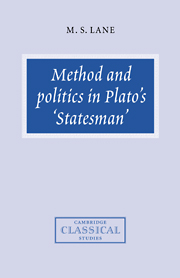Part II - The story as a fulcrum of the dialogue
Published online by Cambridge University Press: 12 September 2009
Summary
Introduction: story-telling and self-criticism
In Part I, we saw that the early divisions concluded with a logos of statecraft given by a systematic division of theoretical expertise: the statesman was defined as the herdsman of the human herd (267a8–c4). Young Socrates was contented with that definition. But the Stranger faulted its completeness and adequacy (267c8–dI). Whereas other herdsmen, for example the cowherd, practised all the arts their herds required – feeding, medicine, matchmaking, midwifery, music – the human statesman is challenged by a competitor in each of these domains. Though the interlocutors had awarded him the title, his claim to it is not secure so long as the challenges of rivals go unanswered (267e1–268c10).
That is as much as the text gives as the occasion for introducing the story. To avoid the disgrace of such an incomplete argument, the Stranger announces, ‘we must travel some other route, starting from another point’, adding when queried, ‘we must bring in a large part of a great story’ (268d5–e2). Yet the resumption of division is envisioned even as the story suspends it. The Stranger continues, ‘we must then – as in what went before – take away part from part in each case and so arrive at the furthest point of the object of our search’ (268d8–e2). The special reason for appealing to a narrative just at this point in the divisions is perplexingly unclear.
Such perplexity is only heightened upon reading through the story thus introduced.
- Type
- Chapter
- Information
- Method and Politics in Plato's Statesman , pp. 99 - 136Publisher: Cambridge University PressPrint publication year: 1998

